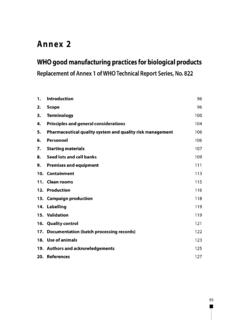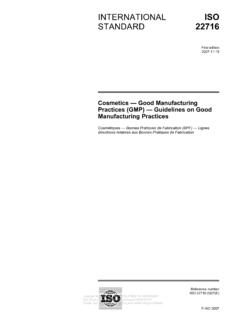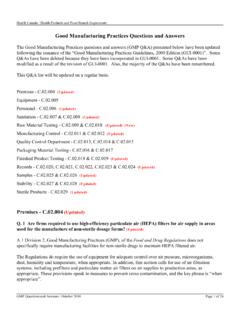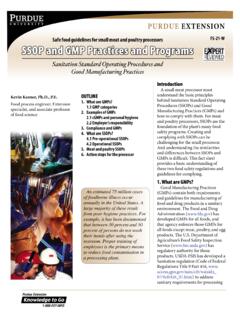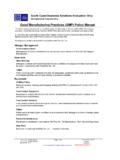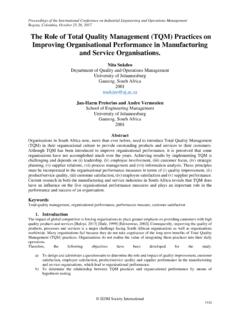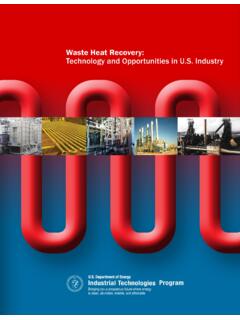Transcription of Good manufacturing practices: water for pharmaceutical use
1 Working document July 2020. 1. 2. 3 DRAFT WORKING DOCUMENT FOR COMMENTS. 4. 5 good manufacturing practices : 6 water for pharmaceutical use 7. Please send your comments to Dr Sabine Kopp, Team Lead, Norms and Standards for Pharmaceuticals, Technical Standards and Specifications with a copy to Ms Claire Vogel before 1 1 September 2020. Please use our attached Comments Table for this purpose. Our working documents are sent out electronically and they will also be placed on the WHO Medicines website ( ) for comments under the Current projects link. If you wish to receive all our draft guidelines, please send your email address to and your name will be added to our electronic mailing list. 8. 9 W o rld Health Organization 2020. 10. 11 All rights reserved. 12. 13 This is a draft. The content of this document is not final, and the text may be subject to revisions before publication.
2 The 14 document may not be reviewed, abstracted, quoted, reproduced, transmitted, distributed, translated or adapted, in part or 15 in whole, in any form or by any means without the permission of the World Health Organiza tion. 16. 17 Please send any request for permission to: 18. 19 Dr Sabine Kopp, Team Lead, Norms and Standards for Pharmaceuticals, Technical Standards and Specifications, Department 20 of Health Products Policy and Standards, World Health Organization, CH-1211 Geneva 27, Switzerland, email: 21. 22 The designations employed and the presentation of the material in this draft do not imply the expression of any opinion 23 whatsoever on the part of the World Health Organization concerning the legal status of any country, territory, city or area or 24 of its authorities, or concerning the delimitation of its frontiers or boundaries.
3 Dotted lines on maps represent approximate 25 border lines for which there may not yet be full agreement. 26. 27 The mention of specific companies or of certain manufacturers' products does not imply that they are endorsed or 28 recommended by the World Health Organization in preference to others of a similar nature that are not mentioned. Errors 29 and omissions excepted, the names of proprietary products are distinguished by initia l capital letters. 30. 31 All reasonable precautions have been taken by the World Health Organization to verify the information contained in this draft. 32. 33 However, the printed material is being distributed without warranty of any kind, either expressed or implied. The responsibility 34 for the interpretation and the use of the material lies with the reader. In no event shall the World Health Organization be 35 liable for damages arising from its use.
4 36. 37 This draft does not necessarily represent the decisions or the stated policy of the World Health Organization. 38. Working document Page 2. 39 SCHEDULE FOR DRAFT WORKING DOCUMENT : 40 good manufacturing practices : 41 water for pharmaceutical use 42. D escription of activity D ate Preparation of the document following recommendation of the Fifty- February- April 2020. fourth WHO Expert Committee on Specifications for pharmaceutical Preparations (ECSPP). Mailing of working document inviting comments, including to the May 2020. Expert Advisory Panel on the International Pharmacopoeia and pharmaceutical Preparations (EAP), and posting of the working document on the WHO website for public consultation. Consolidation of comments received and review of feedback. June 2020. Preparation of working document for discussion. Discussion of the feedback received and the working document with 28 and 29 July 2020.
5 A working group of inspectors during virtual meetings in lieu of the planned Consultation on good practices For Health Products Manufacture and Inspection. Preparation of working document for next round of public July 2020. consultation. Mailing of the revised working document inviting comments, August 2020. including to the EAP, and posting the working document on the WHO. website for a second round of public consultation. Consolidation of comments received and review of feedback by a sub- September 2020. team composed of the participants of the virtual meetings. Preparation of working document for discussion. Presentation to the Fifty-fifth ECSPP meeting. 12-16 October 2020. Any other follow-up action as required. 43. 44. Working document Page 3. 45 good manufacturing practices : 46 water for pharmaceutical use 47. 48 Background 49.
6 50 water quality, including microbiological and chemical quality, throughout production, storage and 51 distribution processes, should be controlled. Unlike other product and process ingredients, water is 52 usually drawn from an on-demand system and is not subject to testing and batch or lot release prior 53 to use. The assurance of water quality to meet the on-demand expectation is, therefore, essential. 54. 55 In recent years, following extensive consultations with stakeholders, several pharmacopoeias have 56 adopted revised monographs on water for injection (WFI) that allow for production by non-distillation 57 technologies. In 2017, the World Health Organization (WHO) Expert Committee on Specifications for 58 pharmaceutical Preparations (ECSPP) recommended that the WHO Secretariat collect feedback on 59 whether or not they should revise the WHO specifications and good manufacturing practices (GMP).
7 60 on WFI, and how to do so. Following discussions during several consultations, the ECSPP agreed that 61 the monograph in The International Pharmacopoeia ( water for injections) and the guideline WHO. 62 good manufacturing practices : water for pharmaceutical use (1), should both be revised to allow for 63 technologies other than distillation for the production of WFI. In early 2019, the WHO Secretariat 64 commissioned the preparation of a draft guidance text for the production of WFI by means other than 65 distillation. Following several public consultations, the text was presented to the Fifty-fourth ECSPP. 66 The Expert Committee adopted the Production of water for injection by means other than distillation 67 guideline and recommended that it should also be integrated into WHO's existing guideline on good 68 manufacturing practices : water for pharmaceutical use.
8 69. 70 This current document is a revision of WHO good manufacturing practices : water for pharmaceutical 71 use, previously published in the WHO Technical Report Series, No. 970, Annex 2, 2011. 72. 73 1. Introduction 74 2. Background to water requirements and uses 75 3. General principles for pharmaceutical water systems Working document Page 4. 76 4. water quality specifications 77 Pharmacopoeial specifications 78 Drinking- water 79 Bulk purified water 80 Bulk water for injections 81 Other grades of water 82 5. General considerations for water purification systems 83 6. water storage and distribution systems 84 7. good practices for water systems 85 8. System sanitization and bioburden control 86 9. Storage vessels 87 10. water distribution 88 11. Operational considerations 89 12. Continuous system monitoring 90 13. Maintenance of water systems 91 14.
9 System reviews 92 15. Inspection of water systems 93 Glossary 94 References 95 Further reading Working document Page 5. 96 1. Introduction and scope 97. 98 This document concerns water for pharmaceutical use (WPU) produced, stored and 99 distributed in bulk form. It provides information on different specifications for WPU; good 100 practices for quality management of water systems; water treatment (production) syst ems;. 101 water storage and distribution systems; commissioning, qualification and validation; sampling 102 and testing; and the routine monitoring of water . 103. 104 The focus of this document is on the treatment, storage and distribution of treated water used 105 in pharmaceutical applications. It excludes the production, storage and usage of water in 106 quality control laboratories. 107. 108 This document does not cover water for administration to patients in the formulated state or 109 the use of small quantities of water in pharmacies to compound individually prescribed 110 medicines.
10 111. 112 The document can be used in whole or in part, as appropriate, to the section and application 113 under consideration. 114. 115 In addition to this document, the Further reading section at the end of this document 116 includes some relevant publications that can serve as additional background material when 117 planning, installing and operating systems intended to provide WPU. 118. 119 This document is supplementary to the World Health Organization (WHO) good 120 manufacturing practices for active pharmaceutical ingredients (2), and the WHO good 121 manufacturing practices for pharmaceutical products: main principles (3). 122. 123 2. Background to water requirements and uses 124. 125 water is a widely used substance in the pharmaceutical industry and other establishments 126 involved in manufacturing pharmaceutical products.










